Asian American seniors, immigrants, those with less education, hit hardest by COVID-19 related job losses and poverty in New York City and State
KEY FINDINGS
In both New York City and New York State:
Counting discouraged workers among the unemployed raises the jobless rates for Asian Americans.
Bangladeshi and Nepalese populations had the highest unemployment rates in 2020.
Chinese and Pakistani populations are the poorest among Asian New Yorkers in 2020.
When compared to the other major racial groups, Asian New Yorkers without a high school diploma experienced the greatest increase in unemployment from 2019 to 2020.
Asian American seniors were the only major racial group whose poverty rate increased from 2019 to 2020.
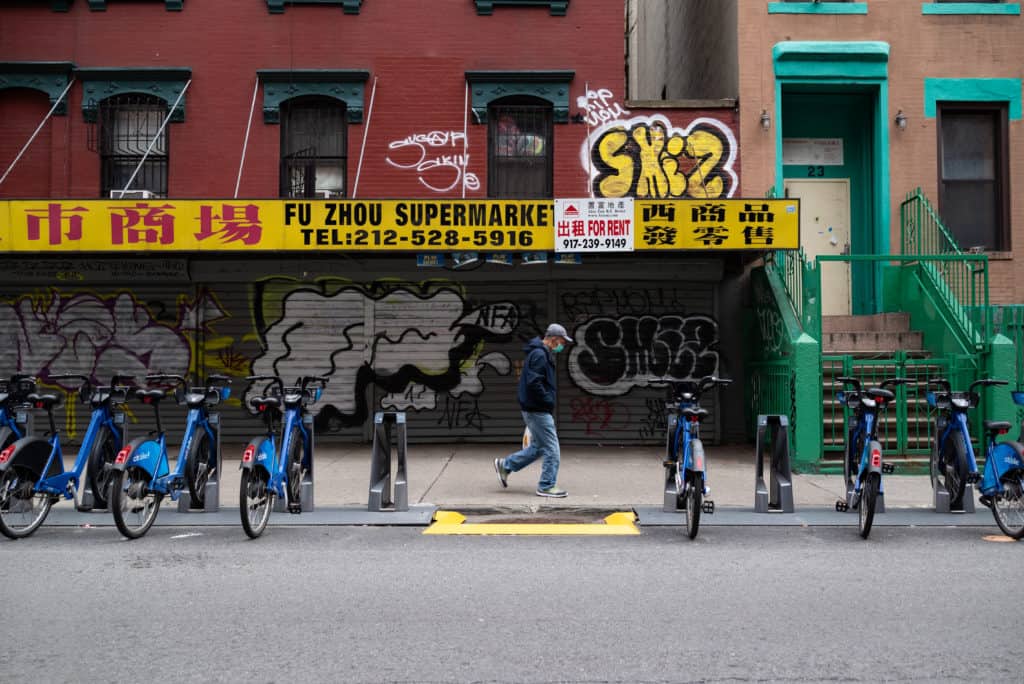
The 2020 American Community Survey (ACS) released by the Census Bureau in January provides an important opportunity for us to take a snapshot at how Asian Americans have struggled with unemployment and poverty during the COVID-19 recession both in New York State and New York City.On aggregate, the Asian American population had lower unemployment and poverty rates than the general population both at the State and the City levels in 2020. However, the Asian American population is diverse with dozens of ethnic subgroups and wide variations in income and educational attainment. Our analysis finds that among Asian Americans, workers without a high school diploma, senior population, and non-citizen immigrants are at greater risk of suffering lasting scars from the pandemic slump.
Note: Due to COVID-19, the Census Bureau faced numerous challenges in collecting information and found significant sampling bias in 2020 ACS data. Read more at the technical notes.
1 of 2
New York State
UNEMPLOYMENT AND JOB LOSS
As the U.S. economy coped with the effects of the COVID-19 recession, a rapidly rising share of Americans found themselves out of a job despite many months of searching. At the same time, a growing number of job seekers became discouraged with the dearth of openings and left the labor force entirely. Therefore, this analysis uses the concept of “joblessness” which includes both those reported as unemployed (yet actively seeking a job) and those known as “discouraged workers” — persons who wanted employment but were not actively engaged in job searching.
As shown in Figure 1, in New York State, counting discouraged workers among the unemployed raises the jobless rate 2.2 percentage points (from 7.7% to 9.9%) for Asian Americans. This compares to the increase of 1 percentage point for White workers, 2.1 percentage points for Black workers and 5.9 percentage points for Hispanic workers. For reference, the overall unemployment rate in New York State increased from 4.5% in 2019 to 8.2% in 2020 and the jobless rate was 10.9% in 2020.
Figure 1. Counting discouraged workers among the unemployed raises the jobless rates for all major racial groups in New York State
New York State Unemployment Rates and Jobless Rates
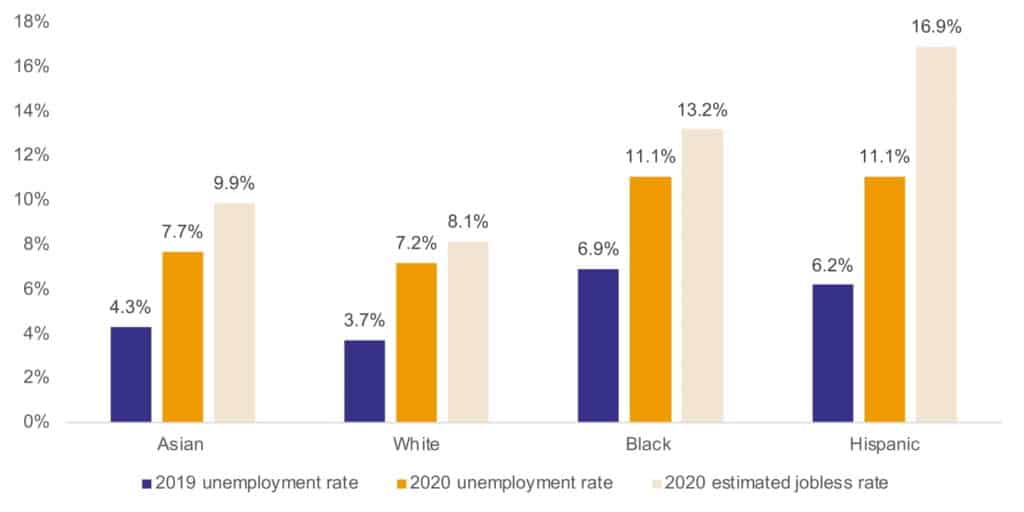
While the unemployment rate of Asian Americans was lower than the State overall rate in 2020, the misperception that Asians “were doing fine” is damaging. In fact, the diverse ethnic subgroups categorized as Asian American show great discrepancies in their employment situation. As shown in Figure 2, the unemployment rates of Nepalese, Bangladeshi, and Japanese workers were the highest among the Asian Americans in 2020. Their respective rates were 22.1%, 15.5% and 8.5%, all which were higher than New York State’s overall unemployment rate of 8.2% in 2020.
Figure 2. In New York State, Nepalese, Bangladeshi, and Japanese populations had the highest levels of unemployment in 2020
New York State Asian American Unemployment Rates
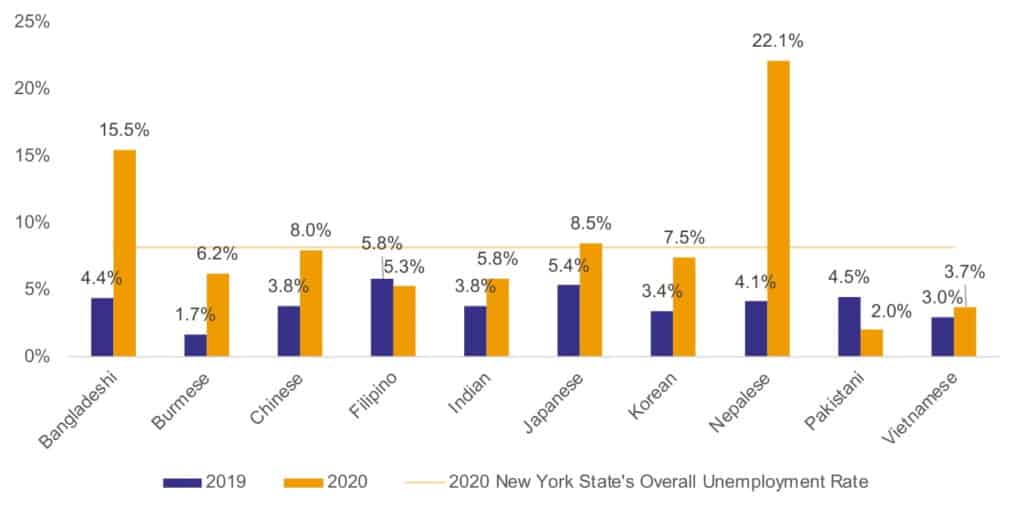
Workers with lower levels of education were affected more by the pandemic. In particular, the unemployment rate of Asian American workers without a high school diploma increased 4.4 percentage points – from 6.0% in 2019 to 10.4% in 2020. This was higher than the respective increases of 3.3 points for White workers, 4.3 points for Black workers and 3.6 points for Hispanic workers (Figure 3).
Figure 3. Compared to the other major racial groups in New York State, Asian American workers without a high school diploma experienced the greatest increase in unemployment from 2019 to 2020
New York State Unemployment Rates of Population (Age 25 and Above) without a High School Diploma
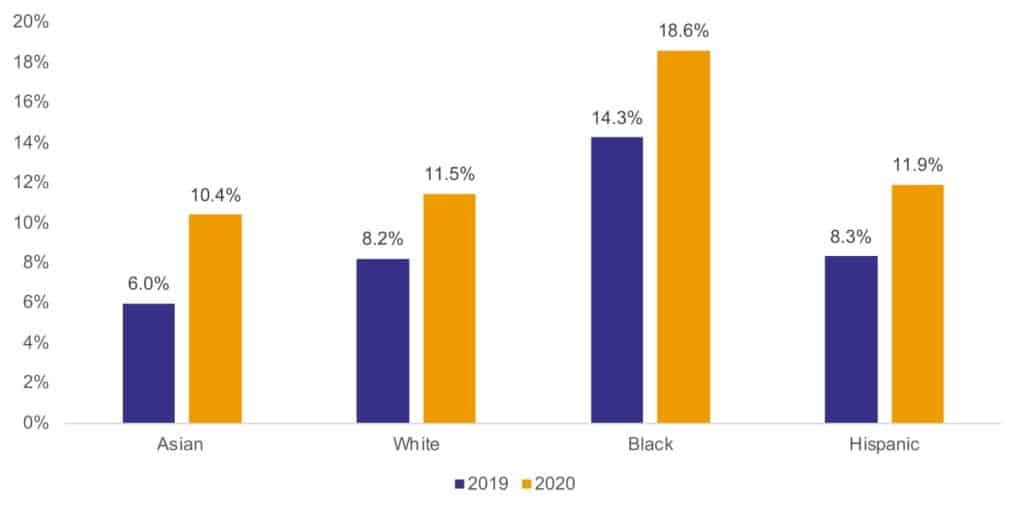
POVERTY
The poverty rate in New York State remained at 12.9% from 2019 to 2020 despite the significant spike in the unemployment rate. Figure 4 shows that Asian American poverty rate, along with the rates of White and Black populations, actually dropped from 2019 to 2020. This could be attributed to the huge expansion in government aid to mitigate the impacts of COVID-19.
Figure 4. Despite a spike in the unemployment rate, the poverty rate in New York State remained stable
New York State Poverty Rates
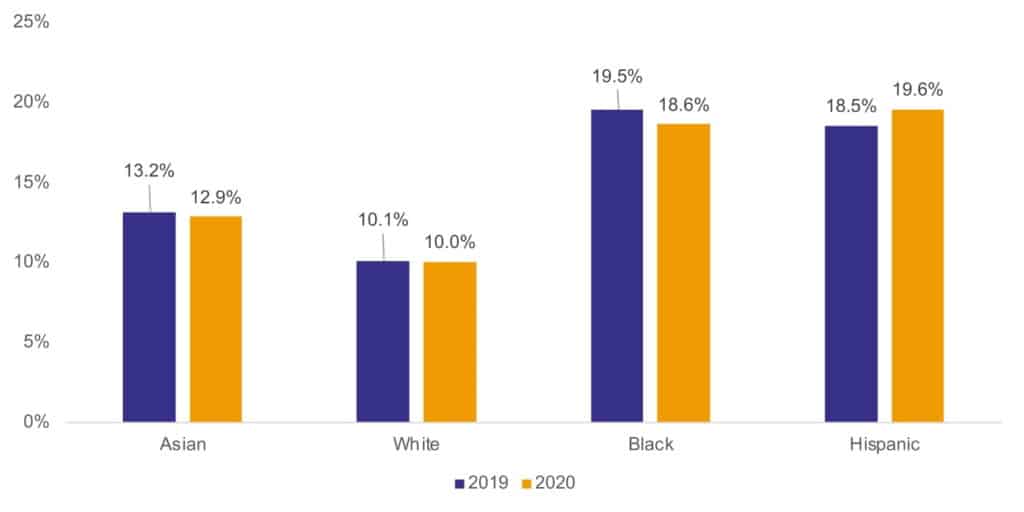
Similar to unemployment rates, poverty rates varied widely among Asian American ethnic subgroups. The poverty rates of Burmese, Bangladeshi, Chinese, and Pakistani American in New York State stood the highest at 23.3%, 17.0%, 16.4%, and 13.5%, all of which were higher than the State’s overall poverty rate of 12.9% in 2020. While we see the poverty rates decrease for Bangladeshi, Indian, Nepalese, and Pakistani Americans from 2019 to 2020, the respective rates of Chinese, Filipino, Japanese and Korean Americans have increased (Figure 5).
Figure 5. Burmese, Bangladeshi, Chinese, and Pakistani Americans were the poorest in New York State in 2020, even as poverty rates varied widely among Asian Americans
New York State Asian American Poverty Rates
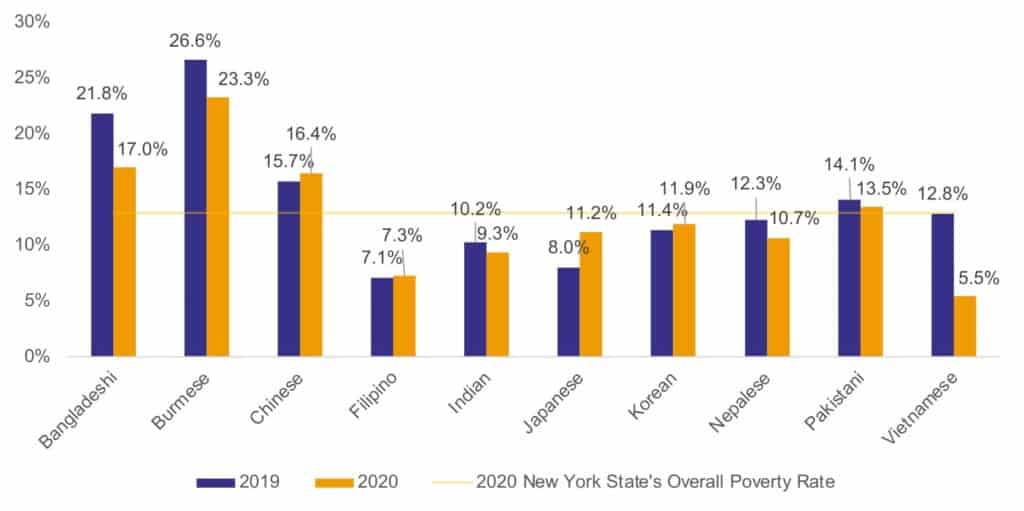
The pandemic has exposed the economic vulnerability of older Asian adults. As shown in Figure 6, the poverty rates of Asian American senior population were 19.6% in 2019 and 19.8% in 2020, surpassing their White and Black counterparts in both years. And the Asian American senior population was the only major racial group whose poverty rate increased from 2019 to 2020.
Figure 6. The Asian American senior population was the only major racial group whose poverty rate increased from 2019 to 2020
New York State Poverty Rates of Senior Population (Age 65 and Over)
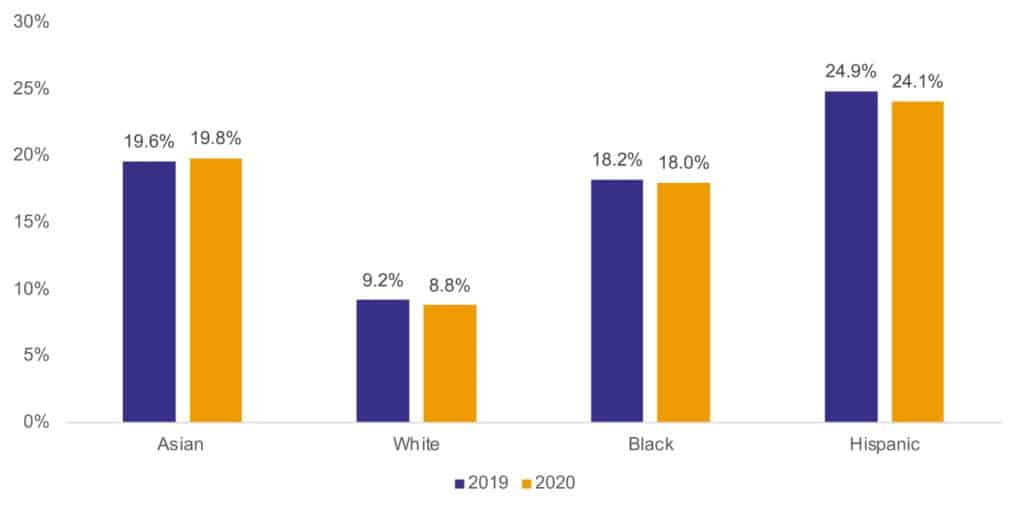
Another group that have suffered significant economic hardships during COVID-19 recession are Asian American non-citizens. Figure 7 depicts the gap between the poverty rates of Asian American citizens and non-citizens — 7.2 percentage points (11.1% for citizens and 18.3% for non-citizens) in 2020. This was bigger than the corresponding gaps of the other major racial groups — 5.7 percentage points for White, 2.1 percentage points for Black and 1.9 percentage points for Hispanic.
Figure 7. The disparity in poverty rates between Asian American citizens and non-citizens was greater than other major racial groups in 2020
New York State Poverty Rates by Citizenship
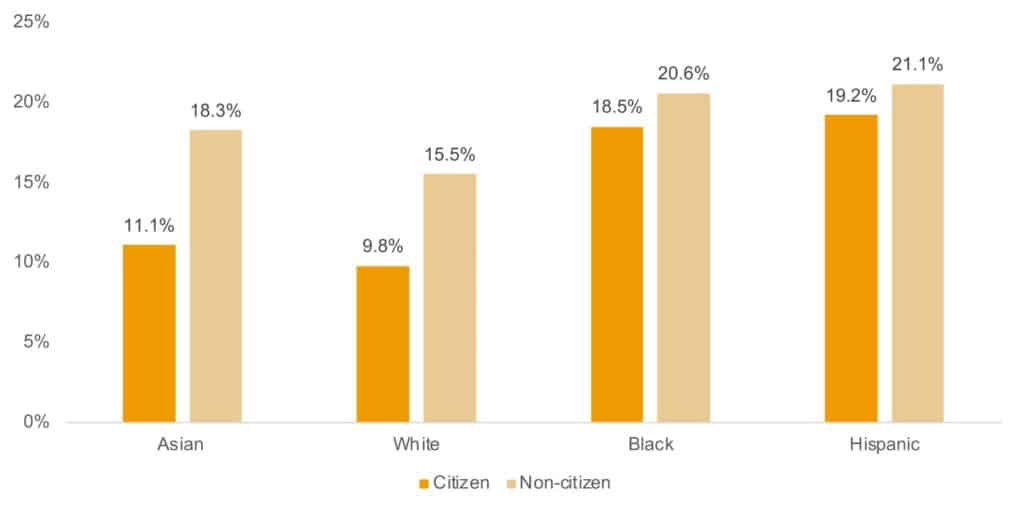
1 of 2
Technical Notes
- The main data sources for this analysis are 2019 American Community Survey (ACS) 1-year Public Use Microdata Sample (PUMS) and 2020 ACS 1-year PUMS with Experimental Weights. The COVID-19 outbreak has limited in-person data collection and affected the response rate for the 2020 ACS. At face value, the 2020 ACS 1-year PUMS makes it appear that the U.S. population had higher levels of education, had more married couples and fewer never married individuals, had less Medicaid coverage, had higher median household incomes, had fewer non-citizens, and were more likely to live in single-family housing units. In the midst of a pandemic that negatively affected so many lives in 2020, these data show that the respondents were not nationally representative and that the weighting methods did not account for the non-response bias.
- 2020 ACS 1-year PUMS’s experimental weighting procedures can mitigate the effects of nonresponse bias, which occurs when the characteristics of people who complete the survey (respondents) differ from those of people who do not complete the survey (nonrespondents). Nonetheless, the Census Bureau does not recommend comparing the 2020 ACS 1-year experimental estimates with their standard ACS estimates or the decennial census or comparing the 2020 1-year PUMS data with standard pre-tabulated products or PUMS-based estimates from previous years.
- Asian Americans in this analysis refer to the Asian alone or in combination with one or more other racesCensus category which includes anyone who identifies as Asian in any way (White Americans refer to White alone or in combination with one or more other races; Black or African Americans refer to Black alone or in combination with one or more other races; Hispanic Americans refers to a person of Cuban, Mexican, Puerto Rican, South or Central American, or other Spanish culture or origin regardless of race). Beginning in 2020, any data comparisons to prior race estimates should be made with caution, taking into account that the Census Bureau implemented changes to the Race question based on extensive research and outreach over the past decade (for more information how Census improved the way the code what people tell them, please see: https://www.census.gov/newsroom/blogs/random-samplings/2021/08/improvements-to-2020-census-race-hispanic-origin-question-designs.html).
- For our purpose, we define the COVID-19 discouraged workers as those who were in the labor market prior to the health crisis but withdrew during the crisis. (This allows us to not include pre-existing discouraged workers and to focus on the effects of the coronavirus shut down.) This definition is operationalized as the increase in population that is not the labor force from 2019 to 2020. The Bureau of Labor Statistics reports U-4 rate which is the number of jobless workers actively seeking work and discouraged workers as a share of workers either at work, actively seeking work or discouraged from the labor force. We did not use the U-4 rate because it is based on data from the Current Population Survey rather than the 2020 ACS 1-year PUMS.
- The sample sizes of Burmese population in 2020 ACS 1-year PUMS with Experimental Weights are 138 in New York State and 51 in New York City. Due to the small sample size in New York City, we did not include the Burmese population in the city level analysis.